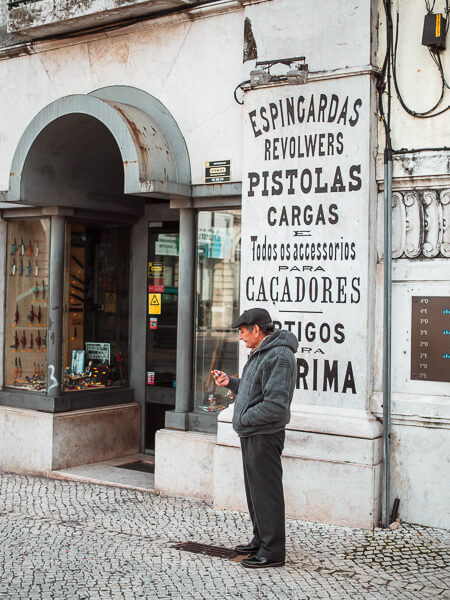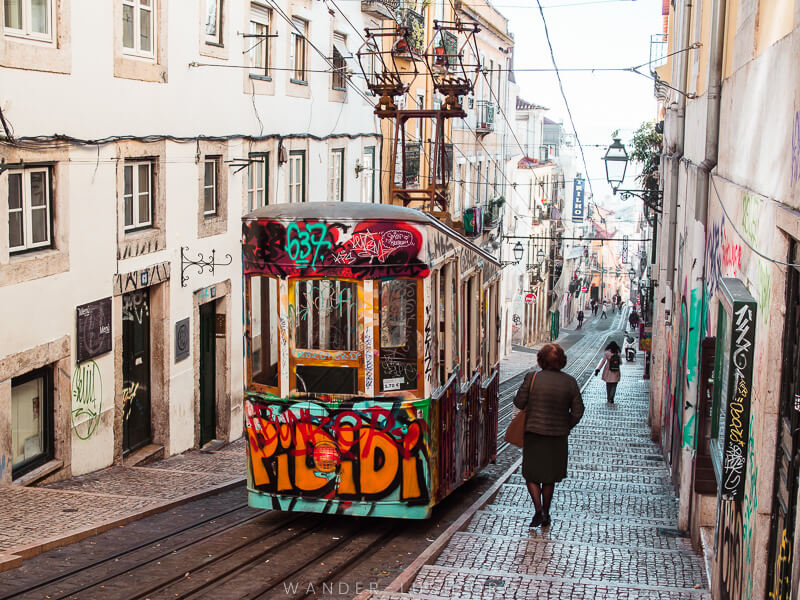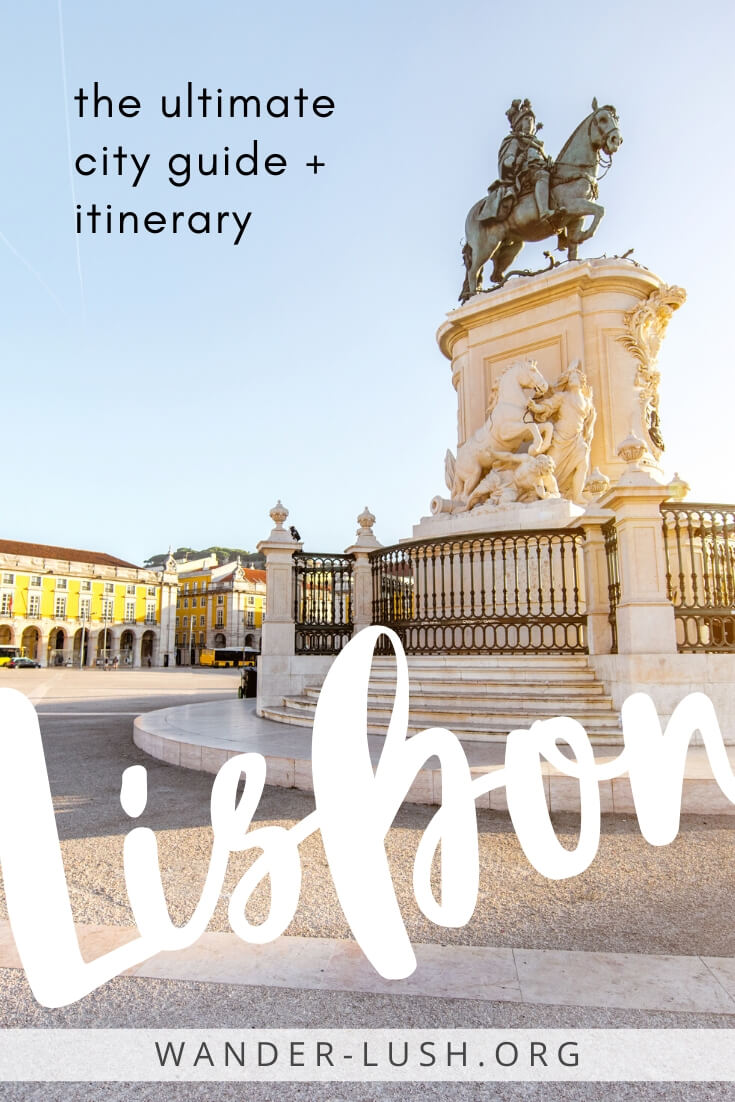Planning a visit to Portugal? This local’s Lisbon guide offers an ideal introduction to the city – including the top things to do in Lisbon, where to eat, which neighbourhoods to stay in, and other practical information for planning the perfect city break.
About the author: Marco Santos moved to sunny Lisbon three years ago on a mission to rediscover his Portuguese heritage. He now shares his passion for exploring Portugal and Spain on his blog, Travel-Boo.
Portugal, and more so Lisbon, is definitely on the up and up thanks to the numerous ‘Top World Travel’ awards it’s garnered in the past couple of years.
Lisbon is one of those rarities – a place that creeps into your heart and never let’s go, captivating anyone who visits.

What exactly makes Lisbon such a truly special place? Perhaps it’s the warm weather and sunshine, the friendly and welcoming people, the gorgeous views, the fantastic food and nightlife, or even the incredible architecture.
In my view, it’s all of the above… And so much more!
My partner and I decided to make Lisbon our home three years ago, and we haven’t looked back. In this city guide, I will be outlining all the relevant info you may need to help plan the very best trip possible, directly from someone who calls this city home!
Please note: This post contains affiliate links, meaning I may earn a commission if you make a purchase by clicking a link (at no extra cost to you). Learn more.
Lisbon guide: Basic Lisbon travel info
- Language: The official language in Portugal is Portuguese. In saying this, most Portuguese – more so in the larger cities such as Lisbon – do speak English fairly fluently. So, you’ll easily get by on English when visiting. Although it won’t hurt to learn a couple of local words, too!
- Forms of payment: Both card and cash are generally accepted in Portugal. Many shops or restaurants will only accept card payment for purchases exceeding €5. Some don’t accept international cards and only allow local Portuguese cards due to the higher merchant costs associated with international transactions. As such, always be sure to carry both card and cash.
- ATMs: You will find ATMs, called multibanco in Portuguese, scattered throughout the city. Withdrawing money from these, even when using an international card, shouldn’t be any hassle.
- Tipping: Generally speaking, tipping is not required in Portugal as staff earn a full-time wage. However, it’s totally up to you. If you feel the service was truly excellent, then absolutely feel free to add a tip. Your waiter will love you!
- Opening hours: Official office hours in Portugal normally run between 9am to 6pm. Lunchtime usually lasts around 2 hours, between 1pm and 3pm. People normally eat Dinner around 9pm at night.


Best time to visit Lisbon
High tourist season in Portugal usually starts in July and lasts through to the beginning of September. During this periods, Lisbon is jam-packed with throngs of tourists, resulting in higher than normal hotel rates.
August and September are also the warmest months. As such, I would highly recommend visiting between May and June or September and October.
If you don’t mind the cold then November and December are also great months to visit. Especially in December during the festive season.
How to get to Lisbon
Considering that Lisbon’s International Airport receives flights from across the globe, travelling to Lisbon from either Europe or abroad shouldn’t pose any problem. Flying directly into Lisbon is unquestionably the easiest way to get to Portugal’s capital city.
Lisbon’s airport is located relatively close to the city centre. You can easily get to your destination using either the metro, bus or taxi.
The red metro line connects Lisbon’s airport with downtown Lisbon and is the preferred method to travel. Alternatively, ride booking services such as Uber, Bolt or Kapten are another option. Since Lisbon is such a compact city, cars can be quite affordable.
Lastly, the Aerobus service runs frequent daily departures between the city and the airport.
Tip: For a hassle-free airport transfer, pre-book an Aerobus ticket or private hotel transfer by car online in advance.
If you’re travelling from Spain, you may also consider getting to Lisbon by bus or train. From Madrid you can catch the overnight RENFE service to Lisbon, arriving at Santa Apolonia train station the next morning.
Bus services such as ALSA or Flixbus also connects other cities within Spain to destinations within Portugal.

Moving around Lisbon
As already mentioned, downtown Lisbon is fairly compact, allowing you to get around pretty much anywhere on foot. This is especially true if your accommodation is located centrally (see the next section for recommendations).
Lisbon does offer a good metro, bus and tram system, making travel further afield a breeze.
The metro system operates four different lines (blue, yellow, green and red) and will require you to purchase a reusable Viva Viagem card for a one-off amount of 0.50€. From there, you can load stored value on the card (for example 3€ or 5€). This is called ‘Zapping’, and you will pay €1.34 per metro journey using this method.
Oftentimes, and especially if you’re travelling as part of a group, it may be worthwhile taking a cab instead. Making use of apps such as Uber, Bolt or Kapten may in fact work out cheaper than taking the metro, depending on where you’re headed.
Planning on doing lots of sightseeing? Then the Lisboa Card may be a good option for you. You can purchase a pass for a predetermined number of days to travel free on trains, buses and trams. It also offers free entry or discounts on some of the major Lisbon sights and museums.
Tip: Pre-purchase your Lisboa Card in advance through Get Your Guide and pick it up as soon as you arrive in the city.
Lastly, you could make use of the many electronic bicycles or e-scooters found throughout the city to get around. These normally require that you download the relevant operator app in order to unlock the bicycle or scooter.
You usually pay per kilometre travelled or on a time basis. Uber also has an e-bike option that you can make use of directly through the app.


Where to stay in Lisbon
Best Lisbon neighbourhoods
Deciding on where to stay when travelling to a new city is always somewhat daunting for me. That’s why I’ve decided to keep my recommendations simple and to the point.
If you’re visiting Lisbon and like to be right in the heart of all the action, then I’d highly recommend you stay in Chiado or neighbouring downtown Baixa. Choosing to do so will almost certainly ensure you can get around all the major sights of Lisbon on foot. Depending on exactly where you stay, Chiado can be a tad bit hilly in places, whereas Baixa is pretty much flat.
On the other hand, if you want peace and quiet and prefer to be slightly further away from the tourist hotspots, then I would suggest basing yourself in the beautiful tree-lined Avenida Liberdade around Marques Pombal or in the posh and leafy suburb of Avenida Novas. Both these areas are still fairly accessible to downtown Lisbon either on foot or by train or taxi.
For a trendy alternative, you may also consider staying in the neighbourhood of Principe Real. Typically considered the LGBT neighbourhood, you’ll find all sorts of hip bars, restaurants and boutique souvenir shops in and around this area. If you’re a gin drinker make sure you visit Gin Lovers in Principe Real, which is set in a stunning Moorish Palace.
Also read: The 20 best Airbnbs in Lisbon.
Where not to stay in Lisbon
Personally, I would not recommend staying in the neighbourhood of Belém. It’s a little way out of the main city centre and will require that you make use of public transport to get around. The tram and bus services into the city from Belém can get very crowded, especially on weekends.
Similarly, I would advise against staying in the older historic neighbourhood of Alfama, especially during the Santos festivals in June when the streets are packed and parties happen every night with music blaring until 3am. We were rather unfortunate to experience this and I can assure you it isn’t pleasant!
Don’t get me wrong – Alfama is gorgeous. But given that certain sections are incredibly steep, it can pose a challenge to travellers with mobility issues. It’s definitely no fun dragging your suitcase up steep cobbled streets, either. Believe me, I’ve experience that too!

Recommended Lisbon hotels
Thankfully, despite the surge in tourism in recent years, Lisbon still remains one of Europe’s more affordable destinations. You can easily bag some great hotel deals in any of the suggested neighbourhoods.
Rates vary of course depending on the season. Prices are considerably higher in the peak period of July through to September.
Here is a selection of my top recommended Lisbon Hotels to choose from.
Budget
- 3* My Story Hotel Ouro – Baixa
- 3* Holiday Inn Express Lisboa – Avenida Liberdade
- 3* HF Fenix Music – Marques de Pombal
- 3* Hotel Expo Astoria – Marques de Pombal
Mid-range
- 4* Evolution Lisboa Hotel – Saldanha
- 4* Lisboa Carmo Hotel – Chiado
- 4* Altis Prata Hotel – Baixa
- 4* HF Fenix Lisboa – Marques de Pombal
Luxury
- 5* InterContinental – Marques de Pombal
- 5* Memmo Principe Real – Principe Real
- 5* Pousada de Lisboa – Baixa
- 5* Bairro Alto Hotel – Chiado
- 5* Tivoli Avenida Liberdade – Avenida Liberdade

5 awesome things to do in Lisbon
I often get asked how long a person should spend in Lisbon and I can confidently say, even if you stayed an entire week in this stunning city, you wouldn’t get bored. It still somewhat surprises me when I hear of travellers spending only one day in Lisbon.
There is honestly so much to see and do in Lisbon, from delicious food and wine, to history, museums, art, entertainment, sightseeing and more.
Here is my selection of the top 5 things you have to see and do on a visit to Lisbon.
Top rated Lisbon city tours & experiences
– Belem Tower Fast-Track Ticket (from €8.60)
– E-bike Tour of Historic Belem (from €36)
– Lisbon Street Art Tour (from €35)
– Live Fado Performance & Dinner (from €20)
– Gourmet Tour and Wine Tasting (from €46.50)
– Make Your Own Portugese Custard Tarts (from €55.40)
1. Check out Belem

When exploring the city, I would recommend that you spend at least half a day discovering all that the Belem neighbourhood has to offer. To get there, head out by train or tram from the Cais do Sodré train station.
Spend some time visiting the notable sights (some of which are UNESCO-Listed). These include the Torre de Belem (Belem Tower), the Discoveries Monument (Padrão dos Descobrimentos), the Jeronimos Monastery (an absolute must visit!), the National Coach Museum, and MAAT (the Museum of Art, Architecture and Technology).
Oh, and don’t forget to go try out the Pasteis de Belem at the Fábrica de Pasteis de Belem, the original home of the famous Pasteis de Nata custard tarts. The bakery started operating in 1837 and incredibly, it’s still in operation today.
2. Explore the oldest parts of Lisbon: Alfama and Castelo

As I mentioned earlier, I personally wouldn’t recommend staying in Alfama. But that’s not to say you shouldn’t visit. I would highly advise spending another half a day getting lost in the narrow, windy and often hilly streets of this beautiful district.
Be sure to check out the Feira da Ladra flea market open on Tuesdays and Saturdays.
Or, enjoy a Fado and dinner show where you’ll get to listen to the melancholic and traditional sounds of the Portuguese folk music, which is said to have originated in Alfama. You’ll also find the Fado Museum located in this neighbourhood.
Ready to ogle at some incredible views? Then check out the Portas do Sol viewpoint as well as the Miradouro de Santa Luzia.
3. Visit downtown Lisbon: Baixa and Chiado

Downtown Baixa is where you’ll find Rossio Square, the Santa Justa Elevator, the Rua Augusta pedestrian shopping street (with the iconic Rua Augusta arch at the end), Praça do Comercio square, and so many more iconic Lisbon landmarks.
Head up to Chiado and visit the Carmo church ruins, the Sao Roque cathedral and the Praça Luis Camoes square. Grab another Pasteis de Nata at Manteigaria while you’re there.
4. Indulge in Lisbon’s food and wine scene


Food lovers will delight in Lisbon’s vibrant food and wine scene. Whether you want to try out some local traditional fare or prefer international cuisine, the city has a lot to offer.
Head to the TimeOut Market (Mercado da Ribeira) in Cais do Sodré for a full-on foodie experience. Here, you can browse the myriad stalls and restaurants and try a selection of Portugal’s finest food and drink.
Alternatively, for a more unique experience, why not book in for a Pasteis de Nata baking workshop. Yes, you can now learn how to make delicious Portuguese egg custard tartlets yourself. There’s even a special vegan-friendly workshop.
After a more refined experience? Then go ahead and book a fine-dining experience at one of Lisbon’s many Michelin starred restaurants. These include Alma, Belcanto, EPUR, Eleven, Feitoria, Fifty Seconds and Loco, where you will no doubt have an unforgettable culinary experience.
5. Enjoy the many viewpoints and rooftop bars

Lisbon is hilly, and when I say hilly, I mean it is known for it’s seven hills! That does mean a lot of steep uphill climbs await. But, once you get to the top, you’ll no doubt be rewarded with incredible views.
This is, in my mind, one of Lisbon’s advantages. I have yet to come across another city with so many different vistas, angles and perspectives to admire.
Head up to one of Lisbon’s many viewpoints (Miradouros) or seek out the closest rooftop bar and take advantage of the sweeping outlooks over the city.
Some of my favourite viewpoints include the Miradouro de São Pedro de Alcântara as well as the Miradouro de Graça. For a stunning rooftop restaurant and bar, head to Topo Chiado, Sky Bar Lisbon or Lost In, to name but a few.

Top 3 day trips from Lisbon
If you do intend to spend 2 days in Lisbon or more, then planning a couple of day trips from Lisbon is an absolute must! Here are my top 3 to consider.
1. Sintra
First on the list of day trips should be fairytale-like Sintra, the former royal summer residence from when Portugal was still a monarchy.
Scattered with palaces, castles and noble estates, Sintra is pure magic! And best of all, it’s only 40 minutes by train from Lisbon’s Rossio train station.
Tip: Pre-purchase your tickets for Pena Palace online and skip the queue.
2. Óbidos
Only an hour away from Lisbon by bus, the medieval walled city of Óbidos is incredibly charming, with its whitewashed houses and cobbled streets. It also plays host to various cultural events throughout the year, including a Chocolate Festival around April/May, the Medieval Festival around July/August and a Christmas Village during the December festive season.
Tip: Join an accompanied tour to Óbidos from Lisbon for an in-depth introduction to medieval Portugal.
3. Cascais
And lastly, at approximately an hour-long journey by train from Lisbon’s Cais do Sodré station lies Cascais. This chilled seaside town is situated on a beautiful coastal stretch running all the way from Lisbon that is often referred to as the Riviera of Portugal.
Swim at fantastic beaches, sample fabulously fresh seafood, and wander through the quaint town centre.
Tip: Take a tour to see the best of Cascais and Sinta in a day.
Lisbon guide: Pin it


More Portugal inspiration
- Beautiful places in Portugal, small towns, islands, national parks & more
- Best cities in Portugal, historic cities & urban metropolises
- One day itinerary for Porto, Portugal’s second city
- The best Airbnbs in Portugal, live like a local
- The best things to do in Portugal, the ultimate wish list
- The best Portuguese souvenirs, what to buy in Portugal
- Best beaches in Lagos, where to go on Portugal’s stunning coast
Great article!
While the train offers convenience, I’d suggest an alternative.
A few years back when I went to Lisbon, I decided to book a guided tour to Sintra and I enjoyed the experience a lot!
It is completely different to explore a place with knowledgeable guides who offer insights into a city’s rich history and attractions!
David